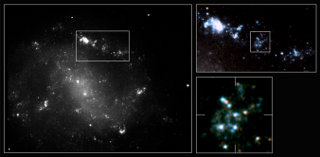First high-resolution details in gamma-ray burst host galaxy: The ESO 184-G82 galaxy has loose spiral arms with many bright star-forming regions. The inset shows an expanded view of one such region. The arrow shows the location Supernova 1998bw. This supernova was probably associated with Gamma-Ray Burst GRB980425, indicating that supernovae are the origin of some GRB's.
Credit: ESA, Stephen Holland (Danish Centre for Astrophysics with the HST), Jens Hjorth, Johan Fynbo (University of Copenhagen)
After 1997, GRB afterglow observations from X-rays to radio helped scientists make meaningful connections between GRBs and astronomical events, such as supernovae, star formation, and cosmology. All research activities were transformed. Old research questions were abandoned for new ones. New types of missions were proposed and built. New types of data analysis appeared, old ones began to seem quaint. A scientific revolution had taken place. The revolution was driven by new observations, and specifically by the advent of a new type of GRB mission.
People now looked to see if a supernova explosion was associated with a gamma-ray burst. The very first one was found serendipitously on April 25, 1998. We just happened to look near the location of the burst with an optical telescope and saw this very, very bright source. This is the nearest ever gamma-ray burst to have been reported—37 megaparsecs from Earth. No wonder it was so bright! It also occurred at approximately the same time as a supernova, designated SN 1998bw. But the connection was disputed. People weren't convinced the supernova was really associated with the gamma-ray burst because the original error box was so large. There was a good probability it was associated, but not 100%, maybe only 99%.
Then in 2003, the HETE-2 satellite provided solid evidence linking long GRBs to the collapse of massive stars. GRB 030329 was among the brightest optical afterglows ever seen, still visible optically after 75 minutes of the initial burst. When we looked at the spectrum, we saw lines there that were broadening every day; the expansion velocity was making them broader; the ejecta from this supernova were expanding at a very high velocity; one of the fastest exploding ejectas ever recorded. Ten days after the GRB 030329, the spectral signature of the Type 1c supernova emerged. The shape was very similar to the spectra of the April 1998 GRB. So in one fell swoop, GRB 030329 affirmed that a supernova can be associated with a gamma-ray burst, and it confirmed that the 1998 GRB was indeed associated with SN 1998bw.


